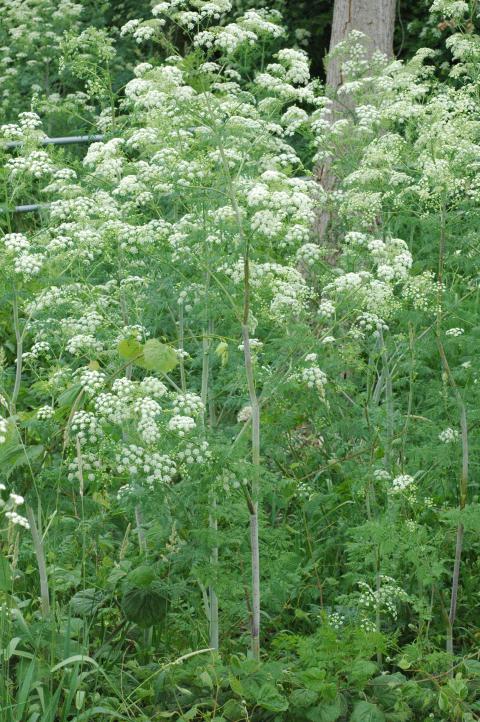Years ago, poison hemlock (Conium maculatum) was brought from Europe and introduced to the United States as an attractive garden plant. But don’t be fooled by its alluring appearance. Poison hemlock is a highly toxic biennial that has spread to nearly every state across the country, with recent infestations reported throughout Indiana, Ohio and Pennsylvania. Its widespread presence now poses a threat to wildlife and roadside safety, causing vegetation managers to search for a reliable control method that can effectively impede its spread.
How to Identify Poison Hemlock and Where to Find It?
Distinguished by its purplish stalk and tiny white flowers that grow in five-petaled umbrella-shaped clusters, poison hemlock is most often found in commonly disturbed areas, including:
- Roadsides
- Edges of cultivated fields
- Creek beds
- Waste areas
- Irrigation ditches
Thriving at lower elevations and in shaded areas with moist soils, this hazardous plant can grow anywhere from 6 to 10 feet tall, making it a serious threat to the environment as well as roadway infrastructure and visibility. Everything from water and flood plains to wildlife and wind are potential carriers that can support the spread of poison hemlock, and because seeds are the plant’s sole source of reproduction, multiple methods can be used to control it. However, some strategies are more effective than others.
How to Treat Poision Hemlock?
Burning poison hemlock is not recommended, as doing so can release the plant’s deadly toxins into the air, endangering wildlife, livestock and humans.
For small infestations consisting of seedlings or small rosettes, manual control methods like hand-pulling can be used. The head of the plant can also be cut off after it starts to flower as long as it is carefully discarded in an enclosed container to prevent seed spreading.
In either case, vegetation managers are encouraged to proceed with caution — oil from the poison hemlock plant is a poisonous irritant that can cause rashes and blisters. Always wear appropriate clothing, gloves, face coverings and eye protection when using manual control methods.
Using TerraVue® herbicide for Poision Hemlock
Considering the biohazards associated with hand-pulling or cutting practices, as well as the risk of stimulating regrowth, many vegetation managers choose to apply selective herbicides during the rosette stage of growth to effectively control larger infestations. In fact, TerraVue® herbicide has been proven to deliver 99% visual control of poison hemlock on roadsides and other natural areas at only 2.85 ounces per acre. As seed remains viable for extended periods of time, routine monitoring is recommended for up to five years post-treatment to ensure complete control throughout all application sites.
TerraVue offers selective control for more than 140 broadleaf weeds and brush species, which allows most desirable vegetation to thrive throughout initial treatment and subsequent applications. As the development of native plants forms a natural barrier against the reestablishment of incompatible vegetation, it significantly reduces the propensity for reinvasion, lowering long-term re-treatment requirements and associated costs as a result.
Failing to effectively control poison hemlock and other hazardous plant species can be not only costly for vegetation management teams but also dangerous for motorists, native plants and various wildlife species. For additional information on recommended techniques, application success stories, industry-leading products and digital training resources, visit VegetationEducation.Corteva.com.
™ ® Trademarks of Corteva Agriscience and its affiliated companies. Under normal field conditions, TerraVue® is nonvolatile. TerraVue has no grazing or haying restrictions for any class of livestock, including lactating dairy cows, horses (including lactating mares) and meat animals prior to slaughter. Label precautions apply to forage treated with TerraVue and to manure and urine from animals that have consumed treated forage. Consult the label for full details. TerraVue is not registered for sale or use in all states. Contact your state pesticide regulatory agency to determine if a product is registered for sale or use in your state. Always read and follow label directions. © 2021 Corteva.



